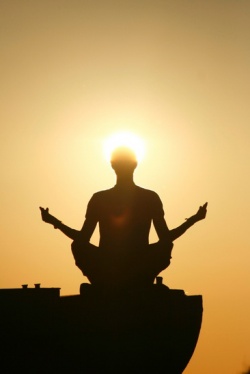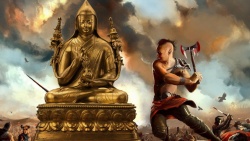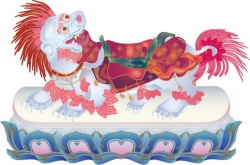Basics of tantra esoteric tibetan buddhism
Editor's note:The Tibetan Buddhism is Great Vehicle (Mahayana) Buddhism. There are two parts of it: the Exoteric and the Esoteric Buddhisms. The Tibetan Exoteric Buddhism is based on Madhyamika (dBu-ma, `middle way') of Nagarjuna. The Tibetan Esoteric Buddhism, which is different from all other Esoteric Buddhisms, makes the Tibetan Buddhism unique. The Tibetan Buddhism requests the study of the Exoteric Buddhism as the foundation and puts the Tibetan Esoteric Buddhism as the most advanced form of Buddhism. We assume that our visitors have a basic knowledge of the Exoteric Buddhism.
The doctrine of the Tibetan Esoteric (i.e. Tantric) Buddhism is based on `Mahavairocana-sutra', and `Kalacakraindriya-sutra'. Its theory may be summarized as follows: "taking the six elements as essence", "five Buddhas and five wisdoms", "taking the four mandalas as appearance", "taking the three secrets as means", "cause, base, final means" and "anger and fear".
"Taking the six elements as essence" is the Esoteric interpretation of the origin of the cosmos. According to the Esoteric Buddhism, the six elements, the earth, water, fire, wind, air and ether ( consciousness), make up the dhamakaya (cosmic body) of the Mahavairocana. They provide the nature of all creation and are at once the source and the foundation of the existence of all phenomena. As they are possessed by all beings in the universe, they exist in the mind of the laity. This is the something Buddha shares with the layman. However, according to the Esoteric Buddhism, the laity are incapable of recognizing the nature of cosmic beings, "unless they are aided by the supreme benevolent power of the Tathagata", which means the practice of "the three secrets" is necessity if one wishes to purify one's mind and recognize the nature of all cosmic beings.
The three secrets are: body secret, speech secret and mind secret. The follower must conform his body, speech and mind to those of the Buddha. "Taking the three secrets as means" refers to a form of meditation during which the meditator, with specified gestures and in specified sitting posture, recites the true teaching of the Satyadevata or yidam (the most honoured of all Buddhas) while concentrating on evoking the deity's image before his inward eye. For the follower, it is not enough to do no evil, for he must impress the image of Satyadevata deeply in his mind. It is not enough to not use any coarse and foul language, for he must recite the deity's true teaching: it is not enough to entertain no wicked ideas, for he must never forget the vows and wishes of the Satyadevata. By doing so, he will eventually be "purified", achieve "the perfect body of the Buddha", and "reach the Buddhahood in the present body".
"The four mandalas" refers to the different types of mandala. The mandala in Sanskrit (Tibetan: dkyil-vkhor) means "rostrum" or "rostrum ground". In ancient India, the mandala was a round or square mud platform at a meditation site erected to ward off "demons" during meditation sessions of the Esoteric Buddhists. When a king ascended to the throne, or when a monk was ordained, the ceremony would take place on a mandala. To these ceremonies, all the deities representing the past, present and the future from all the cosmic compass points (east, west, south, north, northeast, northwest, southeast and southwest from high above and down below) would be invited as witnesses to these occasions, and on the platform their images would be drawn. Later on, different types of mandala were developed, of which the following four are the most common:
1. The Great Mandala, at which the presence of the deities from their respective areas are drawn in green, yellow, red, white and black to represent "the earth, water, fire, wind and air".
2. The Samadhi mandala, at which the presence of the deities is shown not by the drawings of their images, but by those of the pearls, swords or wheels they carry so that the meditators may associates these objects with the images of the deities and practise visionary meditation.
3. The Dhama Mandala, at which the deities are not represented by the drawings of their images, or those of the objects they carry, for it is believed that the sight of the initial syllables in Sanskrit of their titles will invoke their images in meditators.
4. The Karma Mandala, where carved, sculptureed or cast figures of the deities are set up to impress the meditators with the vivid, life-like sight of these deities.
The mandala is the manifestation of the Mahavairocana and the occasion on which he spreads his teachings to earthy beings so that the worshippers of mandalas, with the aid of the Tathagata, will be able to "dispel the clouds of troubles and spiritual obstacles". As the spiritual communication with deities can be done only by means of the four mandalas and by reciting their true teachings, the practice is described as "taking the four mandalas as appearance".
"Five Buddhas and five wisdoms" is one of the major doctrines of the Tibetan Esoteric Buddhism. According to the doctrine, one will not "reach Buddhahood in the present body" just by reciting the true teachings and practising the mandala. He needs the five wisdoms of the Five Dhyani-Buddhas (Vairocana, Aksobhya, Ratnasambhava, Amitabha and Amoghavajra), namely the wisdom of the universal law, the wisdom of the mirror, the wisdom of equality, the wisdom of distinction and discernment, and the wisdom of accomplishing works. When a person has acquired the five wisdoms, he will be able to achieve Buddhahood without abstaining from meat,wine or sex. However, these wisdoms cannot be obtained unless they are passed on by the guru himself. The concept represented by "the five wisdoms" is a spiritual requirement, essential to anyone seeking Buddhahood. It is a concept which promised mystical transforming power.
The "cause, base and final means" is the condensed version of the three lines in the Mahavairocana-sutra:
The mind of bodhi is the cause.
The great compassion is the base.
The upaya (path,method) is the final means.
The first line means that followers of the Esoteric doctrine must first achieve the mind of bodhi. such mind will grow like a seed and eventually lead one to Buddhahood. Without this mind, no one can hope to be accepted by the Buddha, and therefore is not qualified for the practice of the Esoteric doctrine. The second line means that the follower must also be a person of great compassion. This compassion will enable him to liberate all beings by encouraging them to practise virtuous deeds in much the same way as root and trunk of a tree give the tree its leaves, blossoms and fruits; hence the term "the base". The third line means the the path the follower takes and the flexibility he is given. "The final means" may be interpreted as "thoroughness" and "the end", representing the objective, while "upaya" can be taken to mean "flexibility" and "ingenuity" in pursuing the final means. In other words, the follower in his pursuit of Buddhahood, may, when condition warrants it, be excused from the observance of some rules of Buddhist discipline. For example, Buddhism forbids sex, but followers of the Esoteric Buddhism may have female companions for meditation.
The practice of having female companions for meditation is called " the union of voidness and happiness" or the union of the two polarities (yab-yum). This practice, based on the theory of the Mahavairocana-sutra and the Vajrasekhara-sutra, is a distinctive feature of the Esoteric Buddhism. Sex is strictly forbidden by the Exoteric Buddhism, but it is part of meditation practice in the Esoteric Buddhism. As Vajrasekhara-sutra says, "How pure is man's mind! It's only natural that lust should change him. Keeping away from lust will restore purity in him, and keeping away from lust means conquering it with another form of lust." Sex is thus shrouded in mysticism and given the role of "conquering lust". It becomes a mean by which the follower of the Esoteric Buddhism can achieve self-purification of his nature. According to the Esoteric Buddhism, "the attraction of lust will draw one into the realm of the wisdom of the Buddha", that is, by means of carnal love the bodhisattva leads one to liberation. This accounts for the fact that the Esoteric Buddhism treats women as offerings. What "The Collected Works of Buddhism Literature" terms as "love for offerings": refers to the love for women. This theme is repeated in the Mahavairocana-sutra, which says,"Satisfy the desire for sex so that all beings will be happy." According to the Esoteric Buddhism, Mahavairocana lives in Heaven like an earthy being- accompanied by the Marici (Queen of Heaven) and surrounded by female attendants. As a result, the rajas (devas and vajras), instructed by Mahavairocana to subdue demons, are in their "wrathful forms" accompanied by devis, their female counterparts.
The Esoteric Buddhism preaches the idea of "taking upaya (compassion) as father and prajna (wisdom) as mother" and takes the union of rajas and devis in each other's embrace as the symbol of "the union of compassion and wisdom". Therefore, to a follower of the Esoteric Buddhism, his spiritual teacher is his father, and the teacher's female companion his mother (dakini), and the great union of happiness of man and woman is the path which will lead to the "acquisition of supernatural powers (siddhi)". This explain why yab-yum is also called "the path of women". The yab-yum, together with its practice that the teaching of the disciple by his teacher is done only privately, has produced a symbolic and arcane language used during meditation. For example, the phallus is called "vajra", the vulva becomes "the lotus flower" (padma), and copulation is described as "entering into the realm of samaya".
Yab-yum and the concept of great happiness originated in Shaktism (Shaktism). According to this sect, all cosmic beings were created by the sexuality of goddesses. Copulation, therefore, was regarded as a form of worship of the goddesses and an expression of reverence for them. These notions were borrowed by the Esoteric Buddhism and, combined with Buddhism doctrines, produced the theory of "the union of voidness and happiness".
In addition to Queen of Heaven and the devis, among the deities revered by the Esoteric Buddhists are, the Rdo-rje gro-lod (the Wrathful Guardian Deity) and the Bhairava Vajra (the fearful Guardian Deity), who are the two deities representing the doctrine of "wrath" and "fear". Rdo-rje and Bhairava Vajra are names for all wrathful and fearful-looking vajras. According to tradition, the Buddha may appear in two forms: sometimes in his real form of Kindness and at other times in his wrathful manifestation. The Mahabhairava Vajra, the principal deity of the Dge-lugs-pa Sect (gelug-pa, new yellow hat), for example, is the wrathful manifestation of Amitayus. The Mahabhairava Vajra, whose duty is to subdue flaming demons, has six faces, six arms, six feet and three eyes. He holds in his hands various kinds of sceptres. He rides a green water-buffalo, wears a helmet studded with human skulls, and has a tiger's skin for a kilt. With flames emitting from his body, he looks extremely wrathful and fear-striking. This fearful look is intended to demonstrate to all beings that to themselves from avidya (ignorance) they must break down all spiritual barriers with the power of wisdom, and overwhelm demons with all the power they possess. In Buddhist terms, all spiritual and material obstacles to Buddhahood are demons which must be tamed, resisted or brought under control with one's innate strength.




